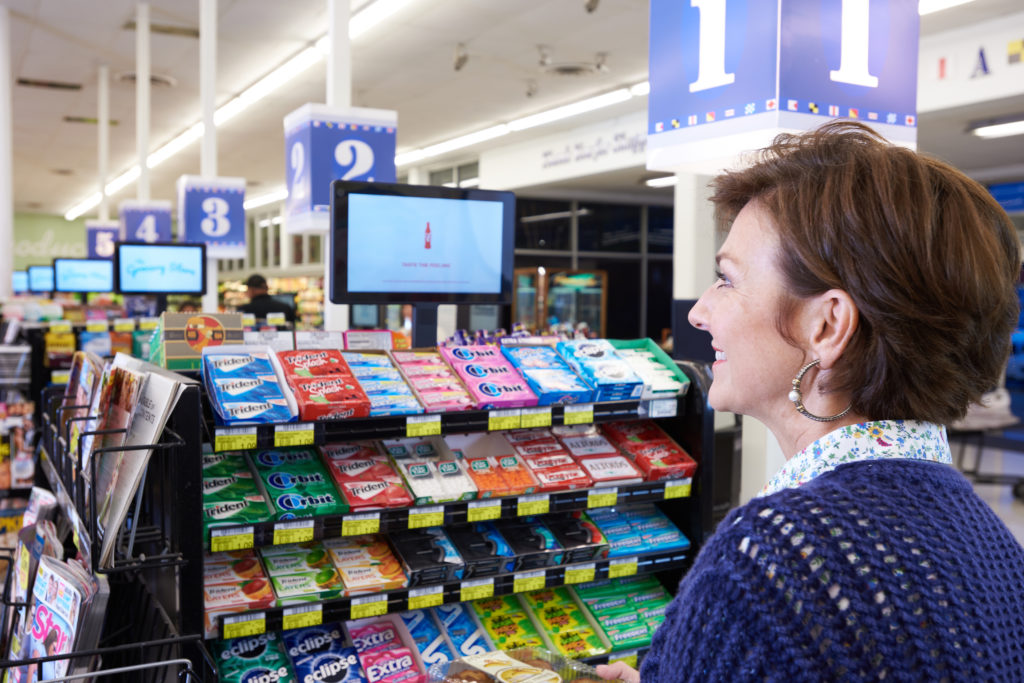Grocery TV is the largest digital network in grocery stores, reaching over 12 million unique shoppers. Grocery TV recently hit a milestone of reaching 1,000 grocery stores in its network, which brings their display count to over 5,100 screens.
The Place Exchange team spoke with Grocery TV’s Nolan Johnson and Marlow Nickell.

What’s your role at Grocery TV?
Nolan: As the Head of Brand Partnerships, I help brands and agencies reach household shoppers in grocery stores across the United States. I’m also responsible for our programmatic partnerships and leading the team where I think our clients will most find value, like programmatic digital out-of-home.
Marlow: I’m the Co-Founder and CEO at Grocery TV. My role involves overseeing the business and filling gaps on the team as we grow. Right now, I’m primarily focused on growing our retailer network and building partnerships with brands.
What are some recent company milestones?
Nolan: Grocery TV expanded to over 1,000 stores nationally this year, which was a huge achievement for our team. Recently, I was proud to kick off a nationwide campaign with the United States Census Bureau with Place Exchange. It was an exciting endeavor that really brought both our clients and teams together to make it happen.
Marlow: One of the most exciting milestones for me was when we launched our first store in late 2017. My co-founders — Edward Cates and Don Oelke — and I built the displays from the ground up (all the hardware and software), so it was pretty surreal seeing our work active in a real store.
Which verticals do you work with most?
Nolan: While CPG is an obvious vertical for us because we’re located in grocery stores, we work with a lot of different brands that are trying to reach our unique audience: the household decision-maker. Because of this, we also work with verticals like insurance, financial, and entertainment to name a few.
Marlow: To echo Nolan, we offer CPG brands the opportunity to advertise in the stores where their products are sold. This makes our network attractive to both front-end brands like Hershey and Mondelez and center-store brands like Bimbo and Post. That said, we work with businesses from a variety of verticals, who want to either be innovative in their marketing strategy or simply add another touch point with their customers.
What types of differentiated data points do you have on the Grocery TV audience?
Nolan: We know that grocery shoppers tend to be household decision-makers. Our platform builds a demographic composite of those decision-makers from each store, so we’re able to set up audience targeting to suit a campaign’s objectives. Using location intelligence, we can reach customers in specific areas based on data such as age, income level, ethnicity, and education.
Marlow: While this is not necessarily audience data, I also wanted to mention that we differentiate ourselves from a data standpoint in how we track impressions. Unlike many others in the industry, we only run content when consumers are within four feet of the displays, which creates a direct relation between plays and impressions. Grocery TV uses computer vision to verify every impression and engagement, meaning that we measure how many shoppers looked at our ads and how long it held their attention.

What do brands enjoy most about using the Grocery TV network?
Nolan: Brands know that when they advertise with us, they’re going to be placed in the heart of the community. It’s a place families rely on to put food on the table, and a lot of the grocers have a “hometown” appeal to them no matter how large they are. As the center of the community, grocery stores are a brand-safe, trusted environment for advertisers to grow awareness. Brands know that they’ll be protecting their positive reputations by advertising in such a reliable space.
Marlow: On top of these reasons, brands enjoy working with our team. We operate like a startup, so we’re quick to adjust to clients’ needs and we’re constantly updating our technology to take advantage of the latest capabilities. We’re not just trying to deliver ads; we strive to provide an experience that customers will love.
What should digital marketers read to stay up to date on Grocery TV news?
Nolan: Here comes a shameless promotion for our blog. Our team has truly insightful pieces that go in-depth about how much sales lift can be traced directly to advertising and the way DOOH has been impacted by COVID-19. We also have a newsletter that shares data about DOOH as well as how advertisers are responding to changes in the turbulent world we’re in. Feel free to shoot me an email nolan@grocerytv.com to be added.
What do you value most in your partnership with Place Exchange?
Nolan: Our team values the way Place Exchange simplifies access to our network, which makes all the difference in an industry that’s often difficult to navigate. I appreciate that the team has been consistently responsive and very easy to integrate with from a technology standpoint. I’m also looking forward to connecting with brands or agencies who may have hesitations about our industry’s analytics capabilities and pleasantly surprising them with our results. My goal is to make an impact on their DOOH experience in ways that will show them just how valuable this channel has become.
Marlow: Echoing Nolan, we’ve really enjoyed working with the Place Exchange platform and, in particular, the team. Our engineers work directly with them, so when problems or opportunities come up they’re easy to address. We even have accounts on the Place Exchange Slack, so they feel like an extension of our team. Looking to the future, we’re excited to grow alongside Place Exchange as more and more advertisers invest in DOOH and Grocery TV.
What are your predictions for Digital Out-of-Home?
Nolan: In the remainder of 2020, we’ll see marketers start to return to DOOH. As states start to open up, there’s a unique opportunity for brands to be part of that celebration and the freedom of being outside the home. Looking ahead, COVID-19 has made it more obvious than ever that programmatic will be a core focus of DOOH. Advertisers are going to want flexibility in the market to be able to change creative and adjust flight dates at a moment’s notice. As the analytics side of DOOH grows, the channel will continue looking more like online digital advertising and less like traditional out-of-home. I’m bullish that the next few years will help fill those analytical gaps that advertisers are looking at.
What are your predictions for the grocery industry?
Marlow: For the grocery retail industry, it’s impossible to talk about the future, without considering the challenges and opportunities created by COVID-19. In the initial weeks and months of the pandemic, grocers faced more customer traffic than they’d ever experienced and dealing with this demand while preserving the safety of their employees and customers was incredibly difficult. Some were better prepared than others — H-E-B, our hometown grocer here in Austin, did a great job — but in fairly short order the industry managed to adapt. Now as we head into the second half of the year, we’re seeing many grocers resume work they’d originally planned for the Spring and Summer, including deploying technology like our Grocery TV displays. In terms of opportunities created, COVID-19 reminded us that the grocery store remains a critical component of communities across our country, and we expect that in the years ahead grocers will invest in technology that continues to maintain this position.